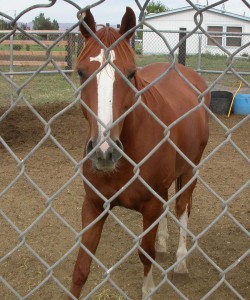Honeycutt was purchased from an Eastern Washington feedlot in July of 2005. He came with no information whatsoever regarding his background, apart from three brands that led us to believe that he was cut from a bucking horse string. We guessed his age to be around 8 years old. From the start, Honeycutt displayed a strong fear of people, and showed signs of significant abuse or mistreatment in his past. Physically he was fine, but he was tense and wary around people, very easily spooked or startled, and initially, quite difficult to catch. He spent his first year with SAFE at our farm in Monroe. He got along quite well with other horses, and gradually became easier to catch once he figured out that no one was going to hurt him. He was gentle and polite when handled on the ground, well behaved for the vet and farrier, and something in his eyes made us believe that he truly wanted to connect with someone, and to be able to trust. But we knew from the start that convincing Honeycutt to let go of his fear was going to take a long, long time.
Initial attempts to ride this horse were unsuccessful, so the decision was made to send him to a professional trainer. He was taught the basics of groundwork, which he responded very well to, and he was carefully started under saddle. Things began to look quite promising for Honeycutt.
But after several months of good progress with his first trainer, Honeycutt started to backslide a bit. Most times he was fine, and his trainer was riding him out on the trails which he really seemed to enjoy. But sometimes, out of the blue, he would start bucking after being saddled or being mounted in the round pen. This began to occur more frequently, until finally his trainer told us that she felt she must have missed something in his training…and she didn’t know what that something might be. She recommended that we send Honeycutt to her mentor, Bill Basham, and have him finish the work she had started.
Bill began working with Honeycutt and discovered a few things. One, Honeycutt was very sore through his back. Two, Honeycutt’s conformation was such that his back sloped downward towards his withers, making saddle fit very very difficult. And three, Honeycutt was a very talented bucker. In addition to these things, Bill felt that Honeycutt did not have the solid foundation of ground work that he would need to establish trust, and that his previous trainer had been “riding his good will” rather than riding a solid foundation of training. And because Honeycutt was so very very tense, they decided that it would be best to go back to basics for a while before trying to ride him.
While Bill’s wife Angie did bodywork on Honeycutt to try to relieve his soreness, Bill worked on the saddle fit problem. In the end he tried about 17 different padding solutions, but nothing really fit this hard-to-fit horse. And Honeycutt continued to escalate his episodes of bucking in the round pen, despite every attempt to saddle him in a way that he would be comfortable. He did make progress while with the Bashams, he started to relax and let go of the tension he carried in his neck and back, and with continued groundwork, they got him back to the point where a rider could ease onto his back from the rail of the roundpen. But Bill said he never felt that it was safe for the rider to even move the horse forward off the rail more than a step or two. Because some days Honeycutt would be fine, and some days he would be explosive. It could not be predicted. So rather than risk anyone’s safety, he chose not to push Honeycutt past that point.
Bill’s final assessment of Honeycutt was that he was too committed to his fears to ever be a safe riding horse. Honeycutt had made it abundantly clear that having a person on his back was unbearable to him. In the end, we decided to listen to what he was telling us. Honeycutt would be available for adoption as a pasture pet or companion horse, and no further attempts to ride him would be made.
Honeycutt is a puzzle, because even after years of careful, gentle and consistent handling, he still remains a very fearful horse. He was cared for three years by one person, someone who loved him very much and did everything she could to gain his trust, and somehow he still never gave up his fear. He is a perfect gentleman, a very neat and clean horse, easy to handle on the ground, the sort of horse that never does anything wrong. Despite his fear, he is not a dangerous horse; he is gentle, careful, and very kind. He has a way of looking at you that is so hopeful and soulful that will break your heart every time. Whatever happened to him in the past, it was bad enough that Honeycutt will probably never recover from it. But there is something absolutely extraordinary about this horse.


